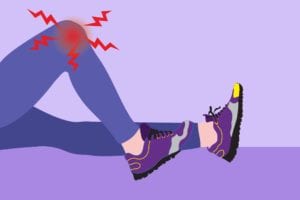

January 1 is a shock to the system. We wake up bleary-eyed and bloated from a six-week booze and cookie bender. We’re broke after buying everyone and their mother gifts (and let’s be honest, ourselves… who else bought their entire wardrobe for next year on Cyber Monday?). Then we have to go back to work, and it’s all: Wait, what do I do for a living? I can’t remember. But I don’t think I like it.
So it makes sense that as a new year begins, many of us want to take stock of our lives and fix things. Some people make New Year’s resolutions every year religiously, and some refuse because they believe resolutions are silly and destined to fail. The stats vary, but research suggests nearly all resolutions fail. According to one survey, one-third of New Year’s resolutions won’t stick past January.
I fall somewhere in the middle. I don’t really love the world “resolution”— it seems so severe and unattainable.
But the truth is, the best resolution, and probably the only resolution, I ever followed through on was quitting smoking seven years ago. It’s one of the most important things I’ve ever done in my life. I have no scientific proof, but I believe my rheumatoid arthritis was triggered by my pack-a-day habit.
So as dumb as resolutions can seem, I’m proof that sometimes they actually work. And, if you have a chronic illness like me, there’s nothing wrong with setting healthy goals, in my humble opinion. They can make a huge impact in your day-to-day life and may even be lifesaving.
My 2019 Health Goals
For 2019, I have plenty of goals, many of which are related to my health and quality of life. I’m going to share those with you (I’ll spare you the “Adopt a new puppy!” or “Clean the hall closet!” ones), because maybe it’ll inspire you to write down a few for yourself. By the way, I’m a big believer in the power of writing things down and there is science out there to back up the benefits. For example, according to a Leadership IQ study called “The Gender Gap and Goal Setting,” people who write down their goals are up to 1.4 times more likely to successfully accomplish their goals.
1) Diversify my workouts
I’m fortunate that my Remicade infusions are working well, knock on wood, so I’m able to exercise quite a bit and I do. (Read more here about the health benefits of exercise for arthritis.)
However, my main flare area is my right foot and I’ve found that the high intensity interval training (HIIT) workouts I do may be too intense literally. I can’t run or jump without pain in my joints, and I don’t want to limp around anymore just to prove I can still keep up with the Joneses. I can’t keep up with the Joneses anymore. Or anyone else in those classes, including my 72-year-old friend Mary, who is a machine.
I’m vowing to listen to my body. I’m going to dial it back a little and do more low-impact activities like weight lifting, hiking, swimming, biking, and walking.
2. Decrease my belly fat
Even though I work out a lot, spoiler alert: I have a big belly that mysteriously appeared like a UFO (unidentified fattening object) right after I got diagnosed with RA. Belly fat is very dangerous. Several studies have shown that there is a direct link between belly fat and dementia, type 2 diabetes, several cancers, including breast cancer, and coronary heart disease, which is already a major problem/red flag for RA patients. There is no magic pill to get rid of abdominal girth. It’s mostly related to diet, which brings me to…

3. Eat better
I refuse to say the word “diet.” More and more persuasive research, including a study of The Biggest Loser contestants published in the journal Obesity, proves that “dieting” does not work long-term; it just messes with our metabolisms and makes us binge, among other dangers. Women “diet” on average seven times in their lifetime and guess what? It’s not working. So, I’m not going to try Whole 30 or keto or paleo. I’m going to ignore the Harvard nutrition professor who suggests we should eat only six French fries at a time. I’m going to cut down on the things that are scientifically proven to be detrimental for RA patients, like sugar, and add the foods that are scientifically proven to be helpful, like the antioxidants found in leafy greens. There’s a new school of thought called “intuitive eating” and it sounds more realistic. You ditch the scale and the meal plans, and instead trust your body to tell you what you need. It’s common sense. We all know what we should do, we just don’t do it. Read more about little ways to cut down on sugar here.
4. Fix my gastro issues
I’m on a bunch of meds, including methotrexate and Remicade, and unfortunately there’s one side effect that really affects my day-to-day life: stomach problems. You probably have them too. Research in the Journal of Rheumatology found that RA patients have a 70 percent higher risk of developing gastrointestinal problems than the general population. And 30 percent of RA patients also have fibromyalgia, which includes the lovely symptom of spastic colon.
Hey, shit happens, what can you do? But seriously, folks, it’s time for me to figure out a way to control my IBS because it’s getting to the point where I can’t function out in the world because my stomach is always rumbling and I’m constantly looking for a bathroom or racing home just in the nick of time, luckily without running anyone over. I did get a speeding ticket once though.
Actually what’s not that funny is that left untreated, GI problems for us are more likely to require hospitalization, the same research found. Mamma mia, diarrhea! I’m sorry, I’m four.
5. Decrease my phone addiction
I don’t know why, but all of a sudden my Big Brother smartphone loves to tell me how much I’m using it per week, and, oh lord, it isn’t pretty! The last update, which popped up out of nowhere and unwanted like a zit, informed me that I’m glued to my phone an average of eight astounding hours per day. This is not okay for several reasons. First, if I’m on my phone, I’m probably sitting like a lump of sludge on my couch. Research in the Annals of Internal Medicine reports that too much sitting is the new smoking and can cause early death. Sedentary behavior is defined as 12 hours per day; I’m already at eight. Hold me.
Second, I need new glasses because my prescription is no longer working and I believe it’s partly due to staring at my phone like a zombie. And finally, I think I may have carpal tunnel from playing a home design game where I win coins and then I get to build a pretty kitchen. I already have hand pain from my RA. Lately I can’t bend my right wrist. I’m not sure if my phone or my disease is the culprit but that horrifying update, which I did not ask for, is a big wake-up call.

6. Stop sitting around like a lump of sludge
The new exercise guidelines for Americans simply say “sit less, move more.” So if I can solve my gastro issues I’m going to get out in the world and cross off some items on my bucket list. I want to get a motorcycle license. I’m kinda into bird watching, who knew? And I want to learn how to play pickleball, a popular new sport, which combines badminton and tennis, and has millions of rabid fans. I can’t play tennis anymore because of my foot pain but pickleball is played on a smaller court, and may be more doable for me. I want in on the sensation sweeping the nation!
7. Advocate for my health — and yours
In 2019, my health insurance payment is going up to $944 per month. I could have a shiny new red Porsche in my driveway; instead I get to sit in a recliner every eight weeks and have meds pumped into my veins. My health insurance costs have skyrocketed — doubling in the past four years — but I have no choice. I must buy good insurance to cover all of my RA-related aches and pains.
I’m grateful and fortunate I’m still able to get insurance but there are so many people who cannot afford good care. It’s time to get involved because nobody is going to care more about my health than me. The first thing I’m going to do in 2019 is sign up for runforsomething.net and figure out how I can ensure that people with pre-existing conditions, like arthritis patients, will always be able to afford insurance. The organization helps young new candidates run for local offices and connect them with resources. Health care is a grassroots issue. You can also join CreakyJoints’ 50-State Network to be a patient advocate that fights for such issues.





